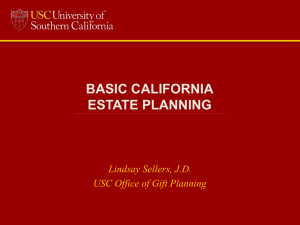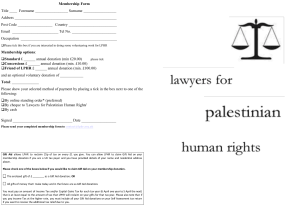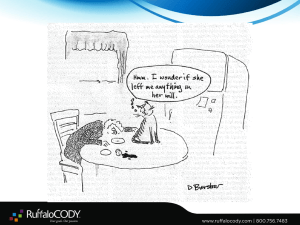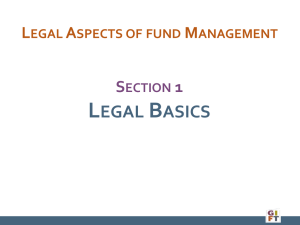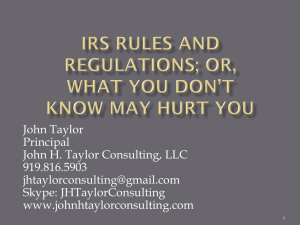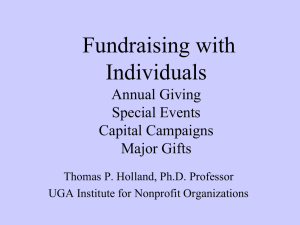Estate and Gift Tax Returns
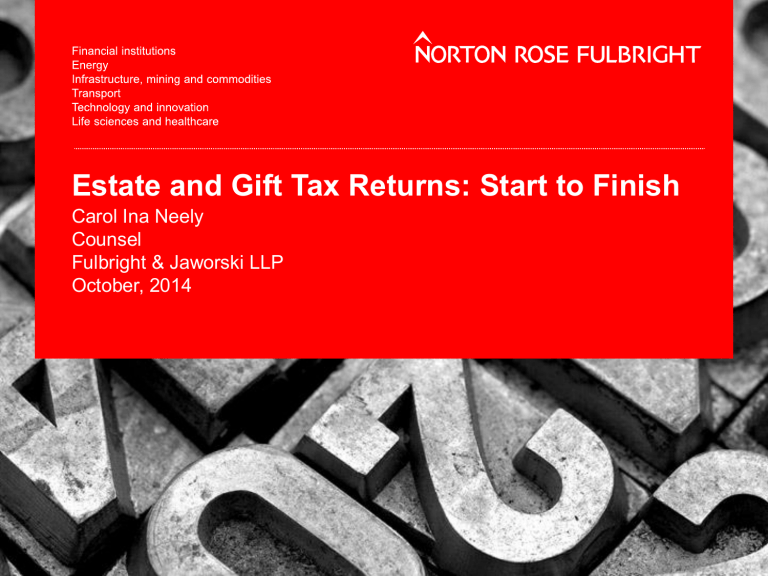
Estate and Gift Tax Returns: Start to Finish
Carol Ina Neely
Counsel
Fulbright & Jaworski LLP
October, 2014
2
Gift Tax Returns and Estate Tax Returns
The purpose of this talk is to cover the basics of preparing and filing federal estate and gift tax returns.
Hours could be dedicated to each topic, so this overview cannot cover all of the issues and details you will encounter. The goal is to give you a basic understanding and hopefully enough information to spot issues as you are preparing and working on these returns.
3
The Gift Tax Return
Form 709 United States Gift (and Generating-Skipping Transfer) Tax Return
Filing Requirements:
• Who
• What
• When
• Where
4
The Gift Tax Return
Form 709 United States Gift (and Generating-Skipping Transfer) Tax Return
Who is required to file a Form 709?
• Generally anyone who made a gift to another person in excess of the annual exclusion amount ($14,000 for 2014) or a future interest.
• Exceptions:
– Gifts between citizen spouses (other than non-qualifying terminable interests)
– Transfers to political organizations
– Payments that qualify for the educational exclusion
– Payments that qualify for the medical exclusion
– Gift splitting between spouses
5
The Gift Tax Return
Form 709 United States Gift (and Generating-Skipping Transfer) Tax Return
What is a gift?
• Any transaction in which an interest in property is gratuitously passed or conferred upon another, regardless of the means or device employed, constitutes a gift subject to tax. Treas. Reg.
§25.2511-1(c)(1)
• This includes (but is not limited to):
– Future interests
– Transfers for inadequate consideration
– The exercise or release of a general power of appointment
– Forgiveness of debt
– Interest free or below market loans
– Transferring the benefits of an insurance policy
– Property settlements
6
The Gift Tax Return
Form 709 United States Gift (and Generating-Skipping Transfer) Tax Return
When to File?
• Form 709 is an annual return.
• A donor must file a Form 709 no earlier than January 1, but no later than April
15, of the year after the gift was made.
• If the donor died during the year the gift was made, the Form 709 is due not later than the earlier of :
–
The due date of the donors estate tax return, or
– April 15 of the year after the gift was made, or the extended due date granted for filing the donor’s gift tax return.
• Extension of Time to File (not an extension to pay).
–
E xtending the donor’s time to file his or her income tax return will automatically extend the time to file the donor’s Form 709
–
Form 8892
7
The Gift Tax Return
Form 709 United States Gift (and Generating-Skipping Transfer) Tax Return
Where to File (as of 2014)?
• By mail:
Department of the Treasury
Internal Revenue Service Center
Cincinnati, OH 45999
• By private delivery service (DHL, FedEx, UPS):
Internal Revenue Service
201 West Rivercenter Boulevard
Covington, KY 41011
8
The Gift Tax Return
Form 709 United States Gift (and Generating-Skipping Transfer) Tax Return
Reporting the gift:
•
Is the donor married?
• Was the gift of community property or will the donor elect to split gifts?
Generally, if you split one gift, you must split them all.
• When is the non-donor spouse required to file a Form 709?
• Is the donee a “skip person”?
9
The Gift Tax Return
Form 709 United States Gift (and Generating-Skipping Transfer) Tax Return
Reporting the gift (Cont.):
• Schedule A
• Gifts Subject Only to Gift Tax
– Gifts made to donor’s spouse
– Gifts made to third parties that are to be split with donor’s spouse
– Charitable gifts
– Other gifts
• Direct skips
– Only those gifts that are currently subject to both the gift and GST taxes
• Indirect skips
– Some gifts made to trusts are subject only to gift tax at the time of the transfer but may later be subject to GST tax.
10
The Gift Tax Return
Form 709 United States Gift (and Generating-Skipping Transfer) Tax Return
Reporting the gift (Cont.):
Sample description of cash bequest to non-skip person
11
The Gift Tax Return
Form 709 United States Gift (and Generating-Skipping Transfer) Tax Return
Reporting the gift (Cont.):
Sample description of cash bequest to a trust that is a skip person
12
The Gift Tax Return
Form 709 United States Gift (and Generating-Skipping Transfer) Tax Return
Reporting the gift (Cont.):
Sample description of cash and securities bequest to a GRAT that may benefit a skip person
13
The Gift Tax Return
Form 709 United States Gift (and Generating-Skipping Transfer) Tax Return
Reporting the gift (Cont.):
Sample description of gift of units in an LLC to a trust that may benefit a skip person
14
The Gift Tax Return
Form 709 United States Gift (and Generating-Skipping Transfer) Tax Return
Allocation of GST Exemption
• Automatic Allocation and 2632 elections
• Direct skip:
– Opt out by a check mark in column C on Schedule A, Part 2 and pay the
GST Tax or pay the GST Tax on a timely fired Form 709.
• Indirect skip (all elections are made by a check mark in column C on Schedule A, Part 3 – so a statement must be attached explaining the election):
– Opt out one time
– Opt out forever
– Opt in
15
The Gift Tax Return
Form 709 United States Gift (and Generating-Skipping Transfer) Tax Return
Sample allocation of GST exemption when no elections are made:
16
The Gift Tax Return
Form 709 United States Gift (and Generating-Skipping Transfer) Tax Return
Other Issues:
• Supplemental Documents (Form 712, Appraisals, any other valuation methodology)
• Reporting non-gift transfers and adequate disclosure – to begin the running of the statute of limitations for a gift, the gift must be adequately disclosed on the Form 709 (or an attached statement). In general, a gift will be adequately disclosed if the return or statement includes:
–
A full complete Form 709
– A description of the transferred property and any consideration received by the donor;
– The identity of, and relationship between the donor and each donee;
–
If the property is transferred in a trust, the trusts EIN and a brief description of the terms of the trust (or a copy of the trust in lieu of such description)
–
Either a qualified appraisal or a detailed description of the method used to determine the fair market value of the gift.
17
The Estate Tax Return
Form 706 United States Estate (and Generating-Skipping Transfer) Tax Return
Filing Requirements:
• Who
• What
• When
• Where
18
The Estate Tax Return
Form 706 United States Estate (and Generating-Skipping Transfer) Tax Return
Who is required to file a Form 706?
For decedents who died in 2014, a Form 706 must be filed by the executor of the estate of every U.S. citizen or resident:
• Whose gross estate, plus adjusted taxable gifts and specific exemption, is more than $5,340,000; or
• Whose executor elects to transfer the DSUE amount to the surviving spouse, regardless of the size of the decedent's gross estate.
For estate tax purposes, a resident is someone who had a domicile in the United States at the time of death.
19
The Estate Tax Return
Form 706 United States Estate (and Generating-Skipping Transfer) Tax Return
What is included in the decedent’s gross estate?
All property in which the decedent had an interest (including real property outside the United States) and it also includes:
• Transfers made during the decedent’s life without adequate security
• Annuities
• Joint interests
• Some life insurance proceeds
• Community property interests
• Property over which the decedent possessed a general power of appointment
20
The Estate Tax Return
Form 706 United States Estate (and Generating-Skipping Transfer) Tax Return
When to file the Form 706?
The executor must file the Form 706 within 9 months after the d ate of the decedent’s death. If the executor is unable to file the
Form 706 by the due date, a Form 4768 can filed to apply for an automatic 6 month extension of time to file the return (but not an extension of time to pay the tax)
21
The Estate Tax Return
Form 706 United States Estate (and Generating-Skipping Transfer) Tax Return
Where to File (as of 2014)?
• By mail or by private delivery service (DHL, FedEx, UPS):
Department of the Treasury
Internal Revenue Service Center
Cincinnati, OH 45999
22
The Estate Tax Return
Form 706 United States Estate (and Generating-Skipping Transfer) Tax Return
What comprises the Form 706:
The Form 706 is comprised of 6 parts and 16 schedules. The six parts to the
Form 706 are where the taxpayer (the executor) provides the identifying information for the executor/estate, computes the tax, makes various elections, signs the return, summarizes what is provided in the various schedules, and calculates the DSUE amount. The schedules are used to determine the gross estate and the deductions applicable to the gross estate.
23
The Estate Tax Return
Form 706 United States Estate (and Generating-Skipping Transfer) Tax Return
Sample Form 706:
As an example, see the attached Appendix which is a sample Form 706 for a hypothetical client.
Decedent, Big Bird, died on January 1, 2013. He was survived by his wife, Pretty Bird, and only child, Cookie Monster. Big Bird resided in a community property state and owned only community property assets. Big Bird died with a relatively simple Will in place that named his wife as the independent executor Big Bird’s Will made the following specific bequests:
• Household goods and personal effects to his wife, Pretty Bird,
• $1,000,000 to his son, Cookie Monster, and
• $1,000,000 to a GST Trust for his son and grandchildren.
Everything else was given outright to his wife, Pretty Bird.
During Big Bird’s lifetime he filed one gift tax return reporting a taxable gift of $100,000 and allocating $100,000 of his lifetime GST exemption to the gift.
24
The Estate Tax Return
Form 706 United States Estate (and Generating-Skipping Transfer) Tax Return
The Form 706 Supporting Documents:
• Death certificate
• Certified copy of the Will
• Forms 712, Life Insurance Statement
• All prior gift tax returns
• Copies of trust agreements created by the decedent or of which decedent was a beneficiary or was granted powers of appointment
• Appraisals/valuation statements
Carol Ina Neely
Counsel
713-651-5266 carolina.neely@nortonrosefulbright.com
25
Disclaimer
Norton Rose Fulbright LLP, Norton Rose Fulbright Australia, Norton Rose Fulbright Canada LLP, Norton Rose Fulbright South Africa (incorporated as Deneys Reitz Inc) and Fulbright & Jaworski LLP, each of which is a separate legal entity, are members (“the Norton Rose Fulbright members”) of Norton Rose Fulbright Verein, a Swiss Verein. Norton Rose Fulbright Verein helps coordinate the activities of the Norton Rose Fulbright members but does not itself provide legal services to clients.
References to “Norton Rose Fulbright”, “the law firm”, and “legal practice” are to one or more of the Norton Rose Fulbright members or to one of their respective affiliates (together “Norton Rose
Fulbright entity/entities”). No individual who is a member, partner, shareholder, director, employee or consultant of, in or to any Norton Rose Fulbright entity (whether or not such individual is described as a “partner”) accepts or assumes responsibility, or has any liability, to any person in respect of this communication. Any reference to a partner or director is to a member, employee or consultant with equivalent standing and qualifications of the relevant Norton Rose Fulbright entity.
The purpose of this communication is to provide information as to developments in the law. It does not contain a full analysis of the law nor does it constitute an opinion of any Norton Rose
Fulbright entity on the points of law discussed. You must take specific legal advice on any particular matter which concerns you. If you require any advice or further information, please speak to your usual contact at Norton Rose Fulbright.
27
